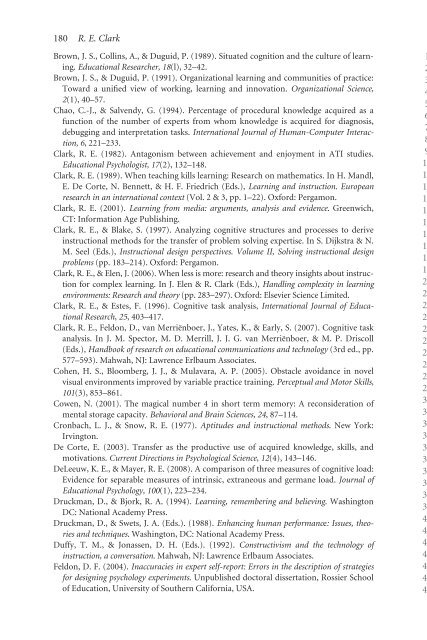9 How Much and What Type of Guidance is Optimal for Learning ...
9 How Much and What Type of Guidance is Optimal for Learning ...
9 How Much and What Type of Guidance is Optimal for Learning ...
Create successful ePaper yourself
Turn your PDF publications into a flip-book with our unique Google optimized e-Paper software.
180 R. E. ClarkBrown, J. S., Collins, A., & Duguid, P. (1989). Situated cognition <strong>and</strong> the culture <strong>of</strong> learning.Educational Researcher, 18(l), 32–42.Brown, J. S., & Duguid, P. (1991). Organizational learning <strong>and</strong> communities <strong>of</strong> practice:Toward a unified view <strong>of</strong> working, learning <strong>and</strong> innovation. Organizational Science,2(1), 40–57.Chao, C.-J., & Salvendy, G. (1994). Percentage <strong>of</strong> procedural knowledge acquired as afunction <strong>of</strong> the number <strong>of</strong> experts from whom knowledge <strong>is</strong> acquired <strong>for</strong> diagnos<strong>is</strong>,debugging <strong>and</strong> interpretation tasks. International Journal <strong>of</strong> Human- Computer Interaction,6, 221–233.Clark, R. E. (1982). Antagon<strong>is</strong>m between achievement <strong>and</strong> enjoyment in ATI studies.Educational Psycholog<strong>is</strong>t, 17(2), 132–148.Clark, R. E. (1989). When teaching kills learning: Research on mathematics. In H. M<strong>and</strong>l,E. De Corte, N. Bennett, & H. F. Friedrich (Eds.), <strong>Learning</strong> <strong>and</strong> instruction. Europeanresearch in an international context (Vol. 2 & 3, pp. 1–22). Ox<strong>for</strong>d: Pergamon.Clark, R. E. (2001). <strong>Learning</strong> from media: arguments, analys<strong>is</strong> <strong>and</strong> evidence. Greenwich,CT: In<strong>for</strong>mation Age Publ<strong>is</strong>hing.Clark, R. E., & Blake, S. (1997). Analyzing cognitive structures <strong>and</strong> processes to deriveinstructional methods <strong>for</strong> the transfer <strong>of</strong> problem solving expert<strong>is</strong>e. In S. Dijkstra & N.M. Seel (Eds.), Instructional design perspectives. Volume II, Solving instructional designproblems (pp. 183–214). Ox<strong>for</strong>d: Pergamon.Clark, R. E., & Elen, J. (2006). When less <strong>is</strong> more: research <strong>and</strong> theory insights about instruction<strong>for</strong> complex learning. In J. Elen & R. Clark (Eds.), H<strong>and</strong>ling complexity in learningenvironments: Research <strong>and</strong> theory (pp. 283–297). Ox<strong>for</strong>d: Elsevier Science Limited.Clark, R. E., & Estes, F. (1996). Cognitive task analys<strong>is</strong>, International Journal <strong>of</strong> EducationalResearch, 25, 403–417.Clark, R. E., Feldon, D., van Merriënboer, J., Yates, K., & Early, S. (2007). Cognitive taskanalys<strong>is</strong>. In J. M. Spector, M. D. Merrill, J. J. G. van Merriënboer, & M. P. Dr<strong>is</strong>coll(Eds.), H<strong>and</strong>book <strong>of</strong> research on educational communications <strong>and</strong> technology (3rd ed., pp.577–593). Mahwah, NJ: Lawrence Erlbaum Associates.Cohen, H. S., Bloomberg, J. J., & Mulavara, A. P. (2005). Obstacle avoidance in novelv<strong>is</strong>ual environments improved by variable practice training. Perceptual <strong>and</strong> Motor Skills,101(3), 853–861.Cowen, N. (2001). The magical number 4 in short term memory: A reconsideration <strong>of</strong>mental storage capacity. Behavioral <strong>and</strong> Brain Sciences, 24, 87–114.Cronbach, L. J., & Snow, R. E. (1977). Aptitudes <strong>and</strong> instructional methods. New York:Irvington.De Corte, E. (2003). Transfer as the productive use <strong>of</strong> acquired knowledge, skills, <strong>and</strong>motivations. Current Directions in Psychological Science, 12(4), 143–146.DeLeeuw, K. E., & Mayer, R. E. (2008). A compar<strong>is</strong>on <strong>of</strong> three measures <strong>of</strong> cognitive load:Evidence <strong>for</strong> separable measures <strong>of</strong> intrinsic, extraneous <strong>and</strong> germane load. Journal <strong>of</strong>Educational Psychology, 100(1), 223–234.Druckman, D., & Bjork, R. A. (1994). <strong>Learning</strong>, remembering <strong>and</strong> believing. WashingtonDC: National Academy Press.Druckman, D., & Swets, J. A. (Eds.). (1988). Enhancing human per<strong>for</strong>mance: Issues, theories<strong>and</strong> techniques. Washington, DC: National Academy Press.Duffy, T. M., & Jonassen, D. H. (Eds.). (1992). Constructiv<strong>is</strong>m <strong>and</strong> the technology <strong>of</strong>instruction, a conversation. Mahwah, NJ: Lawrence Erlbaum Associates.Feldon, D. F. (2004). Inaccuracies in expert self- report: Errors in the description <strong>of</strong> strategies<strong>for</strong> designing psychology experiments. Unpubl<strong>is</strong>hed doctoral d<strong>is</strong>sertation, Rossier School<strong>of</strong> Education, University <strong>of</strong> Southern Cali<strong>for</strong>nia, USA.1234567891111111111222222222233333333334444444
















